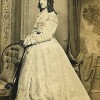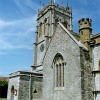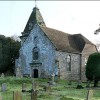Leaving Weymouth and travelling two miles north east along the A 353 towards Overcombe, one draws close to an area known as Furzey Cliff. This feature lies within the ownership of the National Trust, but something of far greater value for Britain’s ancient heritage is also here – or rather was, but for the disappearance of all but its foundations. It was a 4th century Romano-Celtic temple of four-square plan, characteristic of the period, a convention which can also be seen in the ground plan of a very similar religious structure the Romans built within the enclosure of the Iron Age hillfort at Maiden Castle. But both there and at Jordon Hill, the site of the temple near Furzey Cliff, all that remains are the footing walls.
The story of how those footing walls re-emerged into the light of day began one day in 1812 when some farm labourers, ploughing a field on the brow of the hill, had to call a halt to their work when their ploughshare struck an object buried in the ground. It was found to be an urn containing a hoard of several hundred Roman silver coins, which the astonished men principally distributed among themselves. Only a remnant of this amazing find found its way to the county museum in Dorchester. And for another thirty years, Jordon Hill would become a focus of growing speculation as to the possibility that a Roman settlement could once have existed there. But who would be responsible for establishing that that was indeed the case?
In 1843 James A S Medhurst was living in the Weymouth district of Melcombe Regis and working as a craftsman specialising in the production of a kind of decorative inlaid woodwork called Tunbridge Ware, after the town of Tonbridge Wells. Tunbridge Ware involved skilled intricate work, commonly taking the form of boxes having small strips of wood glued together. Woodcraftsmanship, then, was Medhurst’s occupation, but the craftsman had a sideline that would eventually lead to the first systemmatic excavation of Jordon Hill; for Medhurst was a keen archaeologist who had already carried out a considerable amount of digging work in Suffolk before coming to live in Weymouth.
The summer of 1842 was a notably dry one. Under such conditions the foundations of buried buildings are apt to be revealed in grassland or cereals as crop marks. At that time Medhurst’s curiosity had been aroused by the failure of the wheat harvest on Jordon Hill, an event which led to his suspicion that an extensive ancient building lay just beneath the surface. Medhurst commenced his preliminary excavation in 1843, and would continue the work over several other seasons throughout the 1840’s.
The archaeologist first unearthed the foundation of a massive stone wall five feet thick enclosing a square of about 35 square feet. Associated with this wall were pottery and coins clearly of Roman origin and consistent in style with a 1st century construction. Early on in the progress of the work Medhurst had sought the opinion and advice of Professor Buckland who, following his inspection of the site, made known his findings to the British Archaeological Association and the Oxford Ashmolean Society in 1844. He gave as his opinion that the stonework Medhurst had unearthed was the foundation of a square-planned Roman temple, an inner square having been the cella or shrine, while the massive outer wall would have been the peristyle or outer collonade of the normal Romano-Celtic type. Interestingly, some later speculated that the structure may have been a signalling station or Pharos for guiding mariners, but most authorities agree that Buckland’s interpretation is correct. The subsequent discovery of a British coin associated with Roman ones has confirmed the fact.
As the excavation work progressed a number of interesting features came to light. The foundations of a short flight of steps marking the entrance were found near the centre of the south wall. Four feet inwards from the topmost step the bases of four slim columns of Purbeck Marble were found, Beyond the north wall were the base and capital of another column, now on display in the County Museum. In addition to Roman coins and fragments of pottery four sackfuls of bull horns and bones were found by Medhurst within the peristyle, evidently the remains of animal sacrifices to the deity worshipped there.
But the most exciting discovery was yet to come. This was a shaft four feet two inches by fourteen feet deep in the south-east corner of the temple area, a feature described in great detail by Hutchins. The shaft had been lined with clay and stone tiles. A cist formed from two oblong stones and containing two small urns, a 21-inch-long sword, an iron crook and bucket handle, two long irons, an iron knife and a steelyard, had been inserted into the base of the shaft. Immediately above the cist was a thin layer of stone tiles arranged in pairs; between each pair lay the skeleton of a bird and a small Roman coin; this arrangement was repeated sixteen times between the top and bottom of the shaft, the sequence being broken midway by the insertion of a second cist containing urns, a spearhead, and an iron sword. The birds had been buzzards, ravens, crows and starlings. The shaft partly underlay the south-east corner of the building. Professor Buckland speculated that the temple had been a shrine to Aesculapius, the god of healing and that the birds and coins had been votive offerings made by Roman families.
Whether the shrine on Jordon Hill had been dedicated to Aesculapius or not, the fact remains that the Romano-Celtic shrines were by no means to be exclusively for the veneration of any one deity once the Romans had established themselves in England. The pre-eminent concern of the new colonists was to consolidate their authority and to give the native Britons to understand that, having arrived in the country in full force, they meant to stay to time indefinite. Any dissent, resistance or outright rebellion would be swiftly and brutally suppressed, but at the same time the tenor of the system of government they established would otherwise be, as a matter of policy, one of peaceful cooperation and neighbourliness. As became clear from James Medhurst’s excavation of a nearby cemetery, the natives responded positively to the Romans friendly overtures, for the dig had revealed the interesting fact that Romans and Celts alike had shared the same communal burial ground. Furthermore, they had also worked together in contemporary potteries discovered and excavated at Sutton Poyntz. But most interesting of all was that this cooperation extended to religious belief as well. Polytheism, belief in the existence of more than one god, was of course endemic to the pagan civilisations and pre-Christian societies, and so the coming of the Romans into contact with the Britons created a fusion of two pagan traditions. Each race worshipped their own pantheon of deities under different names, but it was quite possible for men of both traditions to practise the sharing of a shrine, to use it for the worship of their own gods and to retain their distinctive beliefs. Cross-cultural identification of deities ruling the same thing (eg: health, love, war) was also commonplace. It was never the policy of the Romans, at least to the very end of the occupation, to ruthlessly suppress the religions of the lands they conquered or forbid on pain of death the worship of all gods but their own.
Consequently the Jordon Hill temple cannot be considered as dedicated to any one particular pagan deity, but was quite likely shared between conquerors and conquered alike. James Medhurst died in 1879, having left Dorset for another part of the country soon after his excavations were concluded. The archaeologist took most of his collection of finds with him but upon his death Pitt Rivers bought a share of the collection and many more of the objects were purchased by or given to several county museums where they are still held today.
But the Jordon Hill site had not given up all its secrets. In 1928, 116 years after the initial find of the urn hoard, a similar discovery was made in the near vicinity of the temple. This time however there was no trace of an urn, the coins having been buried loose as a hoard within the ground and simply covered over with a stone slab. It was, and remains, the largest hoard of Romano-Celtic bronze coins ever to be found anywhere in the Roman Empire. As this find was obviously one of considerable importance the coins were entrusted to Mr F S Salisbury, a noted expert numismatist. His description of them is given in detail in Vol 51 of the Proceedings of the Dorset Archaeological Society. Following classification of the currency it was intermediately entrusted to Mr Mayne & Co, owners of the then Weymouth Bay Estate, who in turn dispatched the coins to the British Museum for re-distribution to Dorchester, Portland and Yeovil Museums as well as to the offices of Weymouth Corporation.
Most of the coins in the Weymouth Hoard of 1928 as they became known, were of 4th century origin, the great majority of them having been minted during the reign of Theodosius 1. This emperor, a successor to Constantine, had decreed Christianity to be the official religion of the empire by the time
of his death in 395 CE, But despite a distinct loosening of the hold of the old gods on the popular imagination of the pre-Christianised Britons towards the end of the 4th century, the advent of Christianity also (paradoxically) brought with it a distinct hardening in attitude on the part of Rome towards the pagan deities. Their worship was declared to be illegal and the offering of sacrifices even became a capital offence.
But what was really interesting about the coins was their marked worn condition, confirming the widely held suspicion that a continuation of the old religion or paganism persisted in the countryside after the Christianisation of the towns, and furthermore, that the Jordon temple site remained in use almost to the very end of the Roman occupation from 410 – 429 CE. Once the Romans had withdrawn from Britain and the value of currency had depreciated, hoarding and burial became the popular way to dispose of the valueless coins. Interestingly, J Collingwood Bruce, in his Handbook to the Roman Wall notes that: “AD 418 The Anglo-Saxon Chronicle says: This year the Romans collected all the treasures that were in Britain, and some they hid in the earth, so that no-one has since been able to find them; and some they carried with them into Gaul…”
Perhaps a few of the temples and shrines that the colonists had built were re-consecrated as Christian oratories, but the remainder were either demolished or abandoned to fall into ruin. It is likely therefore that the Jordon Hill temple was one of the last to go, given the evidence of the long duration and late abandonment of the site. The Romans may have destroyed the building before (or as) they left, or, as is more probable, it was simply deserted and left to rot.
By 1931 the whole of Jordon Hill had passed into the possession of the Weymouth Bay Estate Company, with a view to development for housing. This clearly posed a threat to the archaeology of the site and brought about an urgent need for the conservation of the already existing structures, plus the imperative for seeking out anything hitherto missed by Medhurst’s excavations. Accordingly Charles Prideaux, and eminent archaeologist member of the Dorset Archaeological Society, was appointed to direct a rescue excavation, his first job being to uncover the site, a task in which he was assisted by volunteers from Weymouth College Field Club. Trial trenches were opened in various directions and the ground opened up to a distance of 15 feet from the outer wall of the temple, but no boundary wall or any other structural find of significance was made. However, many objects of interest did emerge, Jewellery, combs, black burnished pottery, as well as coins and iron nails. The following year Col Charles Drew, curator of Dorset County Museum took over from Prideaux as director, but was no more successful in locating structural finds of note, although, again, more artefacts would be revealed. Indeed, by the time these excavations were concluded 88 Roman coins and one Celtic coin had been recovered. This brought the total found in direct association with the temple to 177. The site was then temporarily covered with a layer of earth as a protection from bad weather and then offered to the nation by the WBCE, passing into the custodianship of HM Office of Works.
Since the Prideaux-Drew excavations were concluded, there has been only one further investigation of the related sites, this being undertaken by Dorset archaeologist Bill Putnam in 1969. Anyone sufficiently interested in researching the subject further can find additional material in Hutchins’ History of Dorset Volume 2 and the Dorset Field Club Proceedings Volumes 10, 21, 44, 51, 53, 54 & 57.



